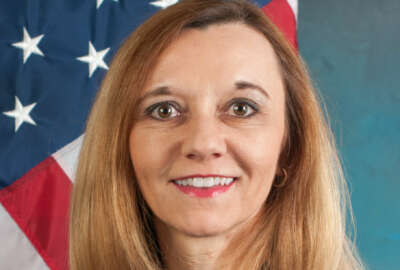
Changing vaccine messaging might reduce reluctance among health care workers
Western University for Health Sciences president Dr. Daniel Wilson says the Biden administration needs to radically change the way the government communicates about...
Best listening experience is on Chrome, Firefox or Safari. Subscribe to Federal Drive’s daily audio interviews on Apple Podcasts or PodcastOne.
How do you get a nation vaccinated when double-digit percentages of frontline health care workers turn down the chance for a shot? One leading practitioner said the Biden administration needs to radically change the way the government communicates about the vaccine. Federal Drive with Tom Temin spoke to the President of the Western University of Health Sciences, Dr. Daniel Wilson, for more insight.
Interview transcript:
Tom Temin: Dr. Wilson, good to have you on.
Dr. Daniel Wilson: Well, good to be with you, Tom.
Tom Temin: And there is a lot of suspicion. I don’t think it’s double digit percentages of the entire population, but we have heard elements that there are people in the health care frontlines that are somehow skeptical of this vaccine, which I guess indicates that people in the general population are. What is it that might cause this phenomenon? Have you seen?
Dr. Daniel Wilson: Well, a couple of things. First of all, there’s always a subset of the population on any subject that will have a contrary view. So that’s not a surprise. And vaccines historically have had some small group of skeptics. This, I think, is a little different in the sense that this disease was not known about a little over a year ago at all, and the type of vaccines that were developed are new, and we’ve never had vaccines developed so rapidly, and produced in such abundance so quickly. It’s really kind of an unprecedented story. And of course, the project in the United States was called warp speed, which sounds good. But on the other hand, it might underscore for some, was this a rush job? Is it really safe? Etc., etc. So I think there’s an understandable aspect to some of the skepticism. But in reality, this is a hugely damaging, dangerous pandemic, with 2 million people around the world who’ve already died. And the syndromes in many survivors are quite serious. So the idea of a vaccine, the sooner we can get large numbers of people vaccinated, the sooner life gets back to normal.
Tom Temin: Sure. And of course, this vaccine and the warp speed effort occurs for the first time in history, when more people listen to nonsense on social media, almost than they do to any authoritative source.
Dr. Daniel Wilson: Well, that’s right, and I confess to looking on social media and the internet for some background information from time to time myself, but that’s no substitute for scientific knowledge. And, you know, to your question about frontline health workers and other workers, you know, just because someone is a clinician in the health professions doesn’t mean that he or she is really an expert on virology or vaccines or what have you. So you would think that they would be more amenable than the general public. And by the numbers they actually are. Nevertheless, it is interesting to see health care workers in particular, decline this vaccine in the face of what is a really awful syndrome.
Tom Temin: And as the Biden administration focuses on the logistics, and the operational aspects of getting this all done, that is to say, the distribution of the vaccines to the states, which have their own problems, getting it out into the arms of people, what do you feel they can do from the communication standpoint, to maybe alleviate some of the suspicion people have about the vaccines?
Dr. Daniel Wilson: Well, first of all, I think the way in which this has happened has been pretty amazing, despite all the rough edges that we’re able to get this out to the people at all in such record time. I think, in that sense, the administration simply needs to refine and hone the work that’s already in place. And that includes everything from the supply chain and logistics of distribution and administration, which is straightening out. I’ve seen it. We have students and faculty all over Southern California who’ve been involved in testing and vaccinations, and everyone says that the knots in the supply and administration are smoothing out. On the communication front, I think that’s really where we could have more impact in terms of getting the facts out but not trying to browbeat people or shame them into, oh, you’re a bad person, because you’re skeptical of a vaccine or you won’t have a vaccine, but simply to get more information out and like in any communication effort to get it out, not once, not twice, but repeatedly and in very clear terms that the general public can understand that this is by any standard, these are safe and highly effective vaccines. And yes, like any medical product, or even any substance, including water, people can have toxic reactions to it. But by the general numbers in the population, the risk to benefit ratio, the benefits so far outweigh the risks, it just behooves everyone to understand that. And the communication from the highest levels of the medical side of the administration, I think, and to some extent the president and others can reinforce it, but to have clear statements about the safety and efficacy of the vaccine for the individuals and the importance for society as a whole to achieve herd immunity as soon as we can.
Tom Temin: We’re speaking with Dr. Daniel Wilson, he’s president of the Western University for Health Sciences. And in the field of medicine, when a new practice or a new procedure is established, there is information sharing, there’s medical journals, there’s ways that the better way, whatever it might be becomes established. And do you sense or are you confident that whatever we have learned about pandemic management, about vaccine development and distribution will be somehow captured? Because this could happen again, already, people are predicting how and why it could happen again, so that we’re not starting from scratch the next time.
Dr. Daniel Wilson: Well, clearly, we’ve learned an enormous amount. I mean, the beginning a year ago, there was sort of misinformation, unfortunately, even from the federal government about, you don’t need mask, it’s not a serious risk of pandemic. And then, you know, by March, that was all reversed. That was unfortunate. But as you say, live and learn. And I have to note that the medical community and all the health professions are garnering information at an unbelievable pace. You can’t read a weekly issue of the Journal of the American Medical Association without having a half a dozen or more articles on COVID, whether it’s technical science and virology, or policy and epidemiology, and even health practices and health systems. So yes, we are learning an enormous amount. The world got caught flat footed by this. We hope that when this is over, or at least substantially subsiding, that we don’t do what we’ve done with past pandemics, like Ebola and others, and just sort of forget about it. The difference here, though, was the speed and scale in which it circulated around the world. Really unbelievable. No one has seen anything like this for 100 years.
Tom Temin: And I guess in some ways, we should be grateful. I was looking up some facts about the polio vaccine. And that did not hit the market until 50 years after the virus that caused it was identified. Here, we’ve done it about a year. So maybe there is some good side to all of this.
Dr. Daniel Wilson: No, absolutely. And a year ago, when I spoke to some of our faculty experts in coronavirus research, several of them said, you know, forget about vaccines, we’ve been trying to develop coronavirus vaccines for two decades. But what I think was different was, again, the scale and intensity of purpose that was put together, certainly in the United States and in other countries in the world to jumpstart this in an unbelievable way. Vaccines actually were created within months. And of course, then it took a few more months to test them. So it was just, it’s really been an unbelievable story, a very positive story. And I think the fact that we have very safe, effective vaccines that appear adaptable to some of these new variants so far, it’s just an extraordinary public health success story that we ought to be celebrating and, you know, really cheering on the efforts to get people vaccinated. Now, I would point out, not everyone has to be vaccinated to achieve herd immunity, anywhere from 60 to 80% of the population either has to have a vaccine or have been exposed and develop natural immunity. So we have 30 million who’ve had the illness, I think in this country and we’re rapidly vaccinating so I think in the next couple of months, between the efforts really smoothing out and ramping up and just the scale. We’re beginning to see the corner on this awful pandemic being turned over the next few months.
Tom Temin: Dr. Daniel Wilson is president of the Western University of Health Sciences. Thanks so much for joining me.
Dr. Daniel Wilson: It’s been wonderful and really appreciate the opportunity to speak with you and to your large audience about an important subject. Thanks so much.
Copyright © 2025 Federal News Network. All rights reserved. This website is not intended for users located within the European Economic Area.
Tom Temin is host of the Federal Drive and has been providing insight on federal technology and management issues for more than 30 years.
Follow @tteminWFED
Related Stories





